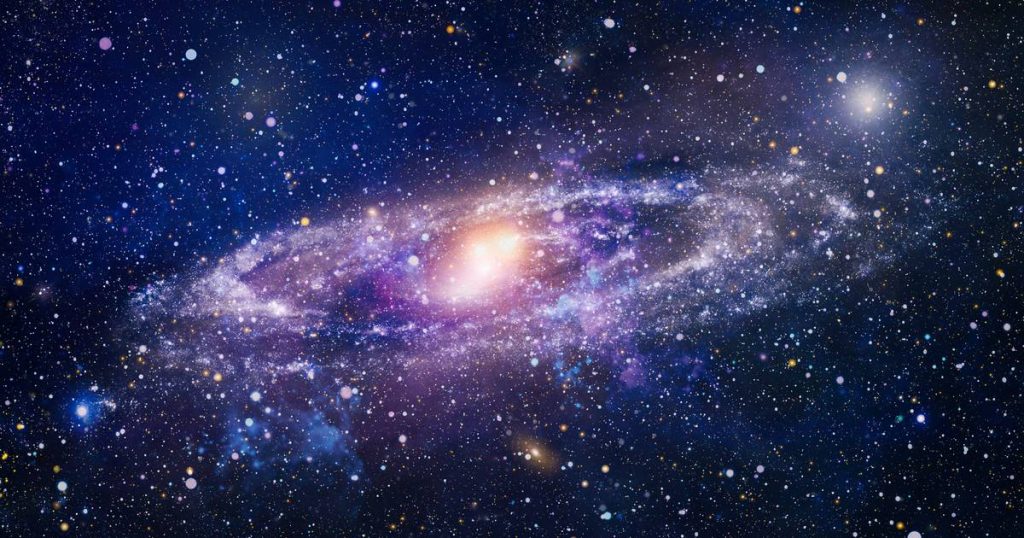A glowing red object in the early universe has been identified as the most distant galaxy yet discovered. Astronomers revealed that this galaxy existed only 330 million years after the Big Bang. The discoverers named the galaxy HD1.
HD1 was discovered as part of a study of galaxies in the early universe. Four powerful infrared and optical telescopes were used: the Subaru Telescope, the Vesta Telescope, the British Infrared Telescope and the Spitzer Space Telescope. Together, they spent more than 1,200 hours of observing time searching for light in the early universe. “Finding HD1 from more than 700,000 objects has been very challenging,” said astronomer Yuichi Harikan of the University of Tokyo in Japan.
It is very difficult to detect things from the early universe. Even quasars, the brightest objects in the entire universe, have dimmed so much over miles of spacetime that our most powerful telescopes struggle to catch their light. “So answering questions about the nature of a very distant resource can be difficult,” said astrophysicist Fabio Pacucci of the Harvard and Smithsonian Center for Astrophysics. Pacucci likens it to guessing the ship’s nationality from the flag that flutters on the mast, while you’re offshore and the ship is in the middle of a storm and thick fog. “One can see some colors and shapes of the flag, but not all. It is ultimately a long game of analysis and ruling out unexpected scenarios.”
Red color
HD1 has a red color known as redshift, which occurs when a light source moves away from us. As a result, the wavelength of light from this source increases towards the red end of the electromagnetic spectrum, which is why it is called redshift.
As the universe expands, other galaxies seem to have redshift, and the greater the distance in spacetime, the greater the redshift. This effect allows astronomers to calculate the distance the light has traveled to reach us. “HD1’s red color matched surprisingly well with the expected features of a galaxy 13.5 billion light-years away, which gave me goosebumps when I found it,” says Harrikan.
But the light from the HD1 is also baffling. It is very bright at ultraviolet wavelengths, indicating that a high-energy process was taking place in the galaxy. At first, researchers thought it was a natural formation of stars, until they calculated how many stars would have to form to produce that much light. The number was incredibly high, more than 100 stars a year. This is 10 times higher than expected for a galaxy in the early universe. However, this tension can be resolved if the stars that are born are not the same as the stars we see being born today.
“The first star clusters that formed in the universe were much denser, brighter, and hotter than modern stars,” Pacuchi said. “If we assume that the stars forming in HD1 are the first, group III stars, then the properties of this star can be more easily explained.” Group C stars can produce more ultraviolet light than regular stars, Pacuchi said, which may explain HD1’s extreme ultraviolet brightness.
quasar
The dim light of HD1, stretched by the expansion of the universe, would have to travel 13.5 billion light-years to reach us here on Earth. So scientists aren’t quite sure what a galaxy is: a starburst galaxy exploding with a star formation or quasar with an active supermassive black hole at its center. If so, the growth of a black hole to supermassive dimensions soon after the formation of the universe poses a challenge to models of black hole formation and evolution.
Quasar is an acronym for Quasi-Stellar Radio Sources, the extremely bright result of an active galactic nucleus, with a supermassive black hole devouring material so quickly that heat generates light waves throughout the universe. To produce the observed light, the supermassive black hole’s mass must be about 100 million times greater than the mass of the Sun, the team estimates. This size puts the growth models of supermassive black holes to the test.
“The black hole in HD1 formed several hundred million years after the Big Bang, so it must have grown from a massive seed at an unprecedented rate,” said astrophysicist Avi Loeb of Harvard University and the Smithsonian Center for Astrophysics. “Again, nature seems more resourceful than us.” The team hopes that future observations using the James Webb Space Telescope, an instrument optimized for looking at the beginnings of the universe, will reveal the nature of this mysterious dawn light.
Read also:
KU Leuven discovered that the closest galaxy to a black hole does not appear to contain a black hole
Unlimited free access to Showbytes? And that can!
Sign in or create an account and never miss a thing from the stars.

“Coffee buff. Twitter fanatic. Tv practitioner. Social media advocate. Pop culture ninja.”











More Stories
Which can cause an increase in nitrogen.
The Central State Real Estate Agency has no additional space to accommodate Ukrainians.
The oystercatcher, the “unlucky national bird,” is increasingly breeding on rooftops.